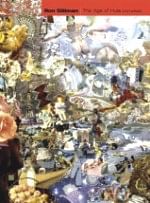|
Book Review
The Age of Huts (compleat)
Andrew Ervin
The Age of Huts (compleat) comes as a welcome collection from Chester County, Pennsylvania's own rabble-rouser-in-residence, poet Ron Silliman. Through his prodigious output and a hugely influential blog that has attracted more than a million hits, Silliman has become a kind of elder statesman in the world of innovative literature. While I'm reluctant to pigeonhole his work, sorry, his “texts”into any specific -ism, there's no denying that The Age of Huts is a shining example of what the language poetry school has contributed to contemporary letters.
 |
The Age of Huts (compleat) by Ron Silliman |
At the risk of gross oversimplification, language poetry demonstrates the ways in which words write us (and therefore construct reality) as much as we write them. The formal structure of The Age of Huts requires some explanation, so please bear with me. According to the preface, Silliman has been working for more than 30 years on a single poem titled “Ketjak.” When complete, it will be made up of four texts: one long poem, “Tjanting” (already available in book form), and three poetry cycles ("The Alphabet,” “Universe” and the present volume, “The Age of Huts").
Stay with me here. The Age of Huts consists of four poems: “Ketjak” (yes, the same title as the entire, decades-old project); “Sunset Debris”; “The Chinese Notebook”; and “2197.”
Confused? We're not done yet. “2197” itself contains 13 separate poems, further contributing to what Silliman calls a “Russian-doll structure.” He has also included a pair of prose poems, “Satellite Texts.” Got all that? It adds up to a complex component of a massive poetic machine, one still under construction.
Or maybe it's still under deconstruction, as The Age of Huts appears to reject the traditional, hierarchical dynamic of poetry in which an exalted Author issues a neatly composed series of proclamations. Silliman has decided to stop making sense. Whatever meaning exists in each poem or conglomeration of poems derives not from some specific message the author hopes to get across, but instead from the interaction of the text with the personal experiences of each individual reader. These poems exist on the page in a state of incompleteness until you, yes, you, come along and contribute your own interpretation.
The opening poem, “Ketjak,” behaves like a cyclical series of self-replicating prose paragraphs in which ideas and sequences of words grow in complexity. It begins with a one-line stanza reading just “Revolving door,” which serves as both a metaphor and a formal model. The poem then expands organically and exponentially until the final, 50-page section of intellectual introspection about everything from childhood memories to the words Silliman is using to describe those memories:
“I did not get my picture of the world by satisfying myself of its correctness. Why these lines, by mere convention, accumulate to form meaning. A big she St. Bernard. Thirty thousand words. The truths of which he says he knows are such as all of us know, if he knows them.
“Sunset Debris” asks quite a lot of the reader, mainly because it contains 40 pages of provocative questions such as “Are you sorry? Are you amusing or amused? Do sentence types limit what we say? Why does my toe ache, my knee feel stiff? Is not communication an act of violence?” Some questions are hilarious, others crude-many are both.
“The Chinese Notebook” contains a list of 223 aphoristic journal entries. They appear randomly ordered, but you may very well find yourself making connections between “101. Before you can accept the idea of fiction, you have to admit everything else” and “156. What if I told you I did not really believe this to be a poem? What if I told you I did?” Narrative here, or the hope of narrative here, is literally whatever you make of it.
The 13 poems in “2197,” the final and longest section of the book, take different forms and allow Silliman to show off his lyrical talents. In them, he takes as his subject nothing less than the entire natural world and the function of language in it. Like everything else in The Age of Huts, these poems defy static meaning, but the imagery does provide the reader with a bit more to work with, as do the “Satellite Texts,” the two prose poems that combine to form a kind of coda.
Silliman's “Ketjak”of which The Age of Huts is only a small partstands among the most ingenious and ambitious poetic endeavors currently under way in American letters. With it, Silliman is actively reshaping what poetry means and causing us to rethink the very nature of language. Can you ask for more than that from any artist? If The Age of Huts provides any indication, we're witnessing the development of what is sure to be a defining literary project of the postmodern era. Good luck, reader.
Source: www.Popmatters.com
Copyright
(R) thedailystar.net 2007 |
